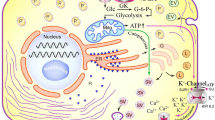Abstract
Reduction of pancreatic β-cell mass is a key element leading to type 2 diabetes. Obesity and overweight with high levels of lipids including cholesterol are tightly linked to type 2 diabetes. The direct impact of cholesterol on pancreatic β-cells, however, has not been extensively studied. In this study, MIN6 mouse β-cell line was used to test the effect of cholesterol on pancreatic β-cell apoptosis over different doses and durations. It was found that cholesterol dose- and time-dependently induced cell death of MIN6 cells above 160 μM after 6 h treatment in vitro. Annexin-V staining revealed that cholesterol treatment significantly induced apoptosis in MIN6 cells. Cholesterol treatment resulted in the loss of the ability to retain Rhodamine 123, indicating mitochondrial damage in MIN6 cells. Cholesterol-induced cell apoptosis and mitochondrial damage were blocked by low-temperature condition. In addition, glutathione also protected MIN6 cells from cholesterol-induced cell death. It is concluded that high level of cholesterol induces cell apoptosis in MIN6 cells, which is in part due to mitochondrial dysfunction. We suggest that excessive uptake of cholesterol in β-cells may contribute to β-cell apoptosis and dysfunction and the deterioration of type 2 diabetes.






Similar content being viewed by others
References
T.T. Goh, T.M. Mason, N. Gupta et al., Am. J. Physiol. Endocrinol. Metab. 292(2), E549 (2007)
S.E. Kahn, Diabetologia 46(1), 3 (2003)
R.H. Unger, Diabetes 44(8), 863 (1995)
D.S. Fredrickson, R.S. Lees, Circulation 31, 321 (1965)
G. Boden, Diabetes 46(1), 3 (1997)
V. Poitout, R.P. Robertson, Endocr. Rev. 29, 351 (2007)
A.Y. Grupping, M. Cnop, C.F. Van Schravendijk et al., Endocrinology 138(10), 4064 (1997)
M. Cnop, A. Grupping, A. Hoorens et al., Am. J. Pathol. 156(1), 237 (2000)
M. Cnop, J.C. Hannaert, A.Y. Grupping et al., Endocrinology 143(9), 3449 (2002)
A. Matsuda, Y. Suzuki, K. Kondo et al., Cardiovasc. Res. 53(2), 512 (2002)
D. Wustner, M. Mondal, I. Tabas et al., Traffic 6(5), 396 (2005)
J. Yin, X. Chaufour, C. McLachlan et al., Atherosclerosis 148, 2–365 (2000)
I. Tabas, Cell Death Differ. 11(Suppl 1), S12 (2004)
A. Colell, C. Garcia-Ruiz, J.M. Lluis et al., J. Biol. Chem. 278(36), 33928 (2003)
G. Leonarduzzi, G. Poli, B. Sottero et al., Front. Biosci. 12, 791 (2007)
L. Ryan, Y.C. O’Callaghan, N.M. O’Brien, Br. J. Nutr. 94(4), 519 (2005)
P.M. Yao, I. Tabas, J. Biol. Chem. 276(45), 42468 (2001)
G. Lizard, V. Deckert, L. Dubrez et al., Am. J. Pathol. 148(5), 1625 (1996)
A. Meynier, A. Andre, J. Lherminier et al., Eur. J. Nutr. 44(7), 393 (2005)
M. Sata, K. Walsh, J. Biol. Chem. 273(50), 33103 (1998)
M. Olson, S. Kornbluth, Curr. Mol. Med. 1(1), 91 (2001)
D.R. Green, J.C. Reed, Science 281(5381), 1309 (1998)
J.D. Ly, D.R. Grubb, A. Lawen, Apoptosis 8(2), 115 (2003)
D.L. Brasaemle, A.D. Attie, J. Lipid Res. 31(1), 103 (1990)
Y. Lange, J. Ye, J. Chin, J. Biol. Chem. 272(27), 17018 (1997)
M. Hao, W.S. Head, S.C. Gunawardana et al., Diabetes 56(9), 2328 (2007)
J.X. Rong, M. Shapiro, E. Trogan et al., Proc. Natl. Acad. Sci. USA 100, 13531 (2003)
Y. Sun, M. Ishibashi, T. Seimon et al., Circ. Res. 104, 455 (2009)
M. Yeh, A.L. Cole, J. Choi et al., Circ. Res. 95, 780 (2004)
L. Yvan-Charvet, C. Welch, T.A. Pagler et al., Circulation 118, 1837 (2008)
Acknowledgment
This work is supported by NH&MRC Australia grant, Eli Lilly Endocrinology Program, and Shaanxi International Cooperation grant (2005KW-17).
Author information
Authors and Affiliations
Corresponding author
Rights and permissions
About this article
Cite this article
Zhao, YF., Wang, L., Lee, S. et al. Cholesterol induces mitochondrial dysfunction and apoptosis in mouse pancreatic beta-cell line MIN6 cells. Endocr 37, 76–82 (2010). https://doi.org/10.1007/s12020-009-9275-y
Received:
Accepted:
Published:
Issue Date:
DOI: https://doi.org/10.1007/s12020-009-9275-y




